10 Ways to Help Students Restore Focus on Learning

Are you a student looking for ways to concentrate during a discussion or while studying? Or are you an educator struggling to restore your students’ focus?
You should understand your body’s needs if you want it to perform optimally. If you engage in a mentally stressful and overwhelming task, your brain may benefit from taking brain breaks.
Students often face real pressures, anxiety, and frustrations during their studies. There are many ways to cope with these struggles, including sports or simply performing short brain breaks.
The Science Behind Brain Breaks
The underlying concern of brain breaks is to give our brain a rest period to reset and refocus. Short mental breaks are intended to help students restore their focus and increase class engagement.
Difficulty in processing and retaining information may arise due to stressful experiences(1). Your mind may feel congested during these events, similar to a traffic jam.
Research has identified stress and the hormones and neurotransmitters released during and after a stressful event as significant modulators of human learning and memory operations. However, recent research also suggests that stress hampers memory-related activities in the brain(2).
When your brain is under stressful circumstances, your brain releases corticosteroids (a class of steroid hormones). These hormones can trigger the amygdala to instruct the hippocampus toward memory consolidation(3).
Amygdala is the part of the brain that processes emotions and fear-associated memories. Alternatively, the hippocampus is chiefly concerned with learning and memory.
Stress may signal to the brain that specific information is worth remembering. However, chronic stress can inhibit the brain’s formation of memories(4).
Examinations, strict deadlines, and interpersonal conflicts are just a few of the many incidents that can cause stress to both students and teachers.
Several difficulties in learning and remembering in the school environment may be due to stress-induced changes(5). Taking insights from psychology and neuroscience into account can improve the educational process for students.
One such insight from brain research is the potential benefits of taking brain breaks.
You may plan for brain breaks to restore the emotional state necessary to ground the amygdala to reality and make it optimal for successful information flow(6).
How Do Brain Breaks Help Students?
Research indicates that when we take breaks, our brains are busy processing memories and assisting in making sense of human experience.
For instance, a 2012 study showed that when brains are in “default mode” (a state of rest associated with mind-wandering), they remain highly active(7).
Typically, you want to introduce brain breaks just before students overly experience exhaustion or boredom.
A three to five-minute brain break or 15 minutes of active play for younger students with a shorter attention span can help students concentrate(8).
In contrast, you can call for a brain break after 30 minutes or more of studying in older students(9).
Reduce Stress, Anxiety, and Restore Focus
One study showed that the active study breaks can(9):
- Relieve stress
- Improve mood
- Increase academic performance
- Improve physical health
- Increase productivity
Another study indicated that brain breaks help students focus more(10).
Resting your brain may help refresh your thinking processes and prepare your mind to learn new skills and concepts. During short brain breaks, the brain refocuses away from memorizing and thinking to another activity.
During these scheduled breaks, the brain moves away from memorizing, learning, and problem-solving. These short breaks refresh the students’ thinking mechanisms and allow their brains to rest and destress.
Boost Happy Hormones
Making your brain breaks engaging and fun may help improve the students’ mood and increase “happy hormones” such as dopamine and serotonin.
You may choose activities that make students laugh, move, listen, and interact with their peers. These recreations may help give them a boost of energy, creativity, happiness, and a good mood.
Motivate Students
Brain breaks can motivate students to attend classes and learn more.
Students who often experience boredom during classes tend to have less knowledge retention.
Studies have shown that boredom negatively affects students’ motivation to learn and achieve. Encouraged students may become more active and attentive in class.
Improves Learning
Studies show that the “spacing effect” can accelerate the learning curve of individuals(11).
The spacing effect indicates that repetitions spaced in time develop stronger memories than repetitions massed in time.
10 Brain Break Ideas to Help Your Students Focus
Brain breaks can appear in different forms depending on the age and activity level of the students. Students can do several mental or physical activities that will help give their brains a break and boost their learning. Here are some brain break ideas you can try:
1. Read Aloud
There are many read-aloud books perfect for giving students a brain break. Reading aloud has also been shown to calm nerves, lessen anxiety, reduce stress, and improve mood.
2. The 5-4-3-2-1 Game
The game requires students to follow the teacher’s instructions and do five different simple exercises in descending order. For example, the teacher could say, “Do five spins, four jumping jacks, three skips or hops, two hips swaying, and one big clap.”
3. The Atom Game
This simple game promotes social skills and interaction with peers. The game begins with the teacher asking the students to move around the classroom like moving atoms. When the teacher calls out a specific number, the students huddle to form groups. For example, the teacher calls out, “Atom five!” Then, the students form a group of five. Participants left with the no group are out of the game.
4. Freeze Dance
Dance is an effective way to exercise and helps increase your heart rate and muscles. This activity can also keep the mind sharp and focused. Let the students move and groove to a catchy song. When the teacher pauses the music, the students freeze and resume dancing as the song continues. Participants who continue moving as the music stops are out of the game.
5. Plate Balance Game
This game improves students’ focus and concentration. Let the students form a group and give each student a paper plate. Each student will balance the paper plate on their head as they walk across the center of the room and back to their group. The fastest group to finish all its members wins the game.
6. Activity Pages
When you don’t have space for physician brain breaks, mentally challenging games are also effective. You may give students activity pages like sudoku, crossword puzzles, or word searches to answer. You may also allow students to answer journal moods or get creative by making appreciation cards.
7. Yoga Poses
Yoga may help clear and refresh the mind. Get the muscles stretched by doing simple yoga poses. They must keep their bodies moving, and minds relaxed.
8. Action Songs
This activity is one of the oldest but most effective ways to do brain breaks. Choose catchy songs and let students act and sing to their hearts’ content.
9. Story Starters
This one doesn’t require too much movement but helps improve critical thinking and creativity. A student begins by creating a story while the next student makes a continuation.
Each student will develop their parts of the story until it ends. This mechanism can be fun for the class to create a longer story together.
10. Brain Tricks
Students can try different brain trick games as a fun way to challenge and improve their coordination skills. You can go with action-based games by asking students to pat their heads while rubbing their stomach and blink one eye while snapping a finger, etc. You can also let them answer riddles or tricky questions. Regular brain breaks throughout the school day are not simply downtime for students. These breaks can benefit students and educators. A short moment to relax and refocus is essential for achieving productivity, success, and a positive outlook.
References
- Protect your brain from stress
https://www.health.harvard.edu/mind-and-mood/protect-your-brain-from-stress
- Learning and memory under stress: implications for the classroom
https://www.nature.com/articles/npjscilearn201611
- How Stress Affects Your Memory
https://www.kqed.org/mindshift/52158/how-stress-affects-your-memory
4. Ibid.
- Learning and memory under stress: implications for the classroom
https://www.nature.com/articles/npjscilearn201611
- Using Brain Breaks to Restore Students’ Focus
https://www.edutopia.org/article/brain-breaks-restore-student-focus-judy-willis
- Rest Is Not Idleness: Implications of the Brain’s Default Mode for Human Development and Education
https://journals.sagepub.com/doi/abs/10.1177/1745691612447308
- 7 Ways to Increase a Student’s Attention Span
https://www.edutopia.org/discussion/7-ways-increase-students-attention-span
- A Signage Intervention Decreases Inactive Study Breaks in College Students
https://library.brockport.edu/BrainBreaks
- Brain Breaks Improve Student Behavior and Focus
https://nwcommons.nwciowa.edu/cgi/viewcontent.cgi?article=1271&context=education_masters
- Spacing Repetitions Over Long Timescales: A Review and a Reconsolidation Explanation
https://www.frontiersin.org/articles/10.3389/fpsyg.2017.00962/full










Informative article for students.